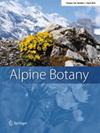Are mountaintops climate refugia for plants under global warming? A lesson from high-mountain oaks in tropical rainforest
Abstract
Climate refugia are locations where plants are able to survive periods of regionally adverse climate. Such refugia may affect evolutionary processes and the maintenance of biodiversity. Numerous refugia have been identified in the context of Quaternary climate oscillations. With climate warming, there is an increasing need to apply insights from the past to characterize potential future refugia. Mountainous regions, due to the provision of spatially heterogeneous habitats, may contain high biodiversity, particularly important during climate oscillations. Here, we highlight the importance of mountaintops as climate refugia, using the example of high-mountain oaks which are distributed on the ranges of the Himalaya–Hengduan Mountains, and at high elevations in tropical rainforests. The occurrences of cold-adapted high-mountain oaks on mountaintops amidst tropical rainforest indicate that such locations are and will be climate refugia as global warming continues. We examine factors that predict the occurrence of future climate refugia on mountaintops using recognized historical refugia. Future research is needed to elucidate the fine-scale processes and particular geographic locations that buffer species against the rapidly changing climate to guide biodiversity conservation efforts under global warming scenarios.

 求助内容:
求助内容: 应助结果提醒方式:
应助结果提醒方式:


